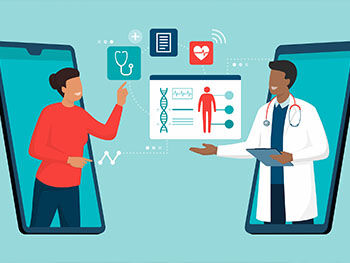Economics lecturer investigating cost-effective healthcare technologies
 A Senior Lecturer in Birmingham City Business School is investigating the benefits telemedicine - the practice of medicine using technology to deliver care at a distance – could have on the UK’s healthcare industry.
A Senior Lecturer in Birmingham City Business School is investigating the benefits telemedicine - the practice of medicine using technology to deliver care at a distance – could have on the UK’s healthcare industry.
Meeting modern healthcare demands
Erez Yerushalmi, Senior Lecturer in Economics at Birmingham City University, is investigating telemedicine, a technology used to raise the supply of healthcare, which is lagging behind the continued rise in the demand for healthcare.
“Innovation in technologies have enabled us to go more digital and change the way we work,” Erez explains. “In terms of healthcare, technology and artificial intelligence can help work alongside doctors and nurses.”
Erez’s project, which is being conducted with RAND Europe, aims to quantify the economic benefits of telemedicine, which will then be useful for policymakers to make more informed decisions.
A full report has been published, with an academic working paper from the Centre for Finance and Economics (CAFÉ) being developed.
Three types of telemedicine
In his report, Erez summarises three types of telemedicine:
- Telemonitoring – Mobile devices that link to platforms that conduct medical tests, able to then communicate with healthcare professionals in real time.
- Store and forward – Digital storage and the sharing of health records across the healthcare system, giving a timely and efficient accessibility of patient health records.
- Interactive telemedicine – Direct real-time communication with patients, using smartphones or computers to communicate with service providers.
The benefits of interactive telemedicine
In his research, Erez is focusing on Canada - a country with a strong public healthcare system and large rural areas.
This means that some patients may need to travel for hours to receive care.
“Currently, four percent of healthcare visits in Canada are done using telemedicine,” Erez says. “In our model, we simulate an increase, rising to 10, 25 and eventually 50 percent.”
Erez and co-authors calculate the time saved from travelling and sitting in waiting rooms. They then use a computable general equilibrium to simulate the positive ripple effects that saving time would have on the economy.
“With more leisure time, a person’s wellbeing rises,” Erez explains. “Through telemedicine, we can enjoy more leisure activities and also lose fewer working hours.
“For example, if Canadians have 50 percent of their healthcare meetings with telemedicine, this would save 100 million hours each year. This adds nearly $3 billion to the economy in terms of GDP and an additional $2 billion in terms of well-being. This is an overall $5 billion."
What’s next for the research?
Erez and the team are now working on some extensions to this research.
“In our model, we have assumed that telemedicine has the same quality of service as meeting face to face with a doctor,” Erez says.
“Our next question is to try estimate the maximum level of quality reduction that could be tolerated before this makes telemedicine an inferior type of method, compared to a face-to-face meeting.
“We believe that this will be another helpful measure for policymakers to have in their search for ways to increase the supply of healthcare.”
Erez has also discussed the research in the latest series of TigerLAB Bites, a series of short videos where experts from the Business School share their latest research.
Read the report here. An academic CAFÉ Working Paper is also being developed.